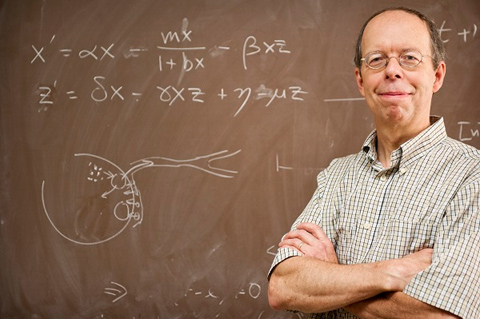
Dr. Todd Young. Photo by Joel Prince, courtesy of the Ohio University Heritage College of Osteopathic Medicine
The Dynamical Systems and Mathematical Biology Seminar presents Dr. Todd R. Young discussing “Temporal Clusters Prefer to be Equally Distributed–an example from the Yeast Cell Cycle” on Tuesday, Sept. 11, from at 3:05 p.m. in Morton 313.
Young is Professor of Mathematics at Ohio University.
His collaborators are Jan Rombouts and Kiattisak Prathom.
ABSTRACT: Synchrony, the phenomenon where components of a system experience events in unison, seems to be common in many systems. Relatedly, Temporal Clustering or Phase Synchrony, is where sub-groups (or cohorts) of components synchronize among themselves, but are out of phase with other cohorts.
In bioreactor experiments on yeast metabolic oscillations we discovered a case where a culture of yeast exhibits temporal clustering in which two groups progress through their cell cycles in anti-phase. In these experiments the cell cycle clusters and oscillations in the metabolism are seen to be tightly linked.
The discovery raises a number of mathematical questions such as: What accounts for the difference between a system that synchronizes and one that forms clusters?, What determines the number of clusters that appear?, and How do individual cells distribute among clusters?
In this talk we will focus on the last question using a biologically motivated non-linear model. We observe in numerical simulations of the model that the clusters tend very strongly toward having nearly equal numbers of cells. This is consistent with the available experimental data. We study the case of two unequal clusters analytically and conclude that solutions with two unequal clusters are locally asymptotically stable in the clustered subspace, but, local asymptotic stability of unbalanced clusters in the full phase space depends delicately on details of the model. However, global dynamics reveal a more robust picture. If clusters become unbalanced, the influence of the larger cluster can radically shift the “basins of attraction” of individual clusters, making it more likely for an unclustered cell to join a smaller cluster. We propose that this points to a general principle: systems that form temporal clusters via non-local coupling tend to form nearly equal clusters.



















Comments